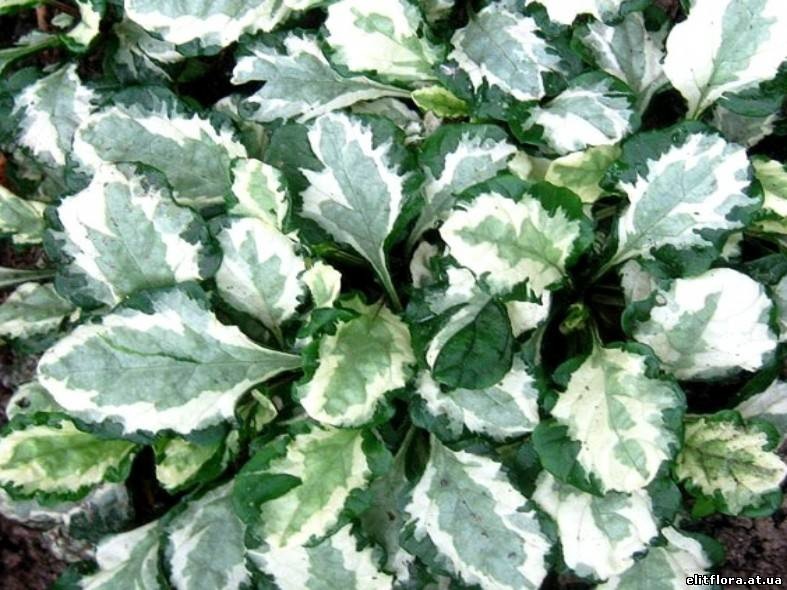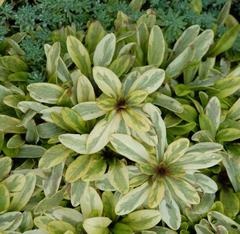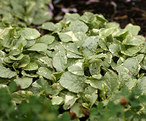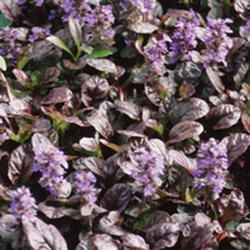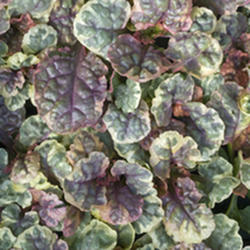Cultivation: Good ground cover plant, although may be considered invasive. Will scorch in full sun. Will tolerate poor soils How to plant: Propagate by cuttings, division or separation - Divide or take cuttings in early summer after flowering has ceased. Maintenance and care: This plant may invade lawns if not kept in check. Can be difficult to eliminate from garden once established. Deadhead to reduce spread by seed and to maintain best foliage quality. Allow good air circulation, and thin plants if overly crowded to reduce risk of rot. Suggested planting locations and garden types: Banks and Slopes Low Maintenance Flower borders and beds Ground Cover Cottage & Informal Garden Wildflower meadow Wildlife Gardens Pruning: No pruning required Diseases: Fungal root rot Southern blight Crown rot Fungal leaf spot May suffer from powdery mildews Varieties http://www.perennials.com/results.html?findplant=Ajuga http://www.bhg.com/gardening/plant-dictionary/perennial/ajuga/ http://www.perennialresource.com/encyclopedia/view/?plant=23 http://www.gardeningknowhow.com/ornamental/foliage/ajuga/ajuga-bugleweed.htm http://www.crocus.co.uk/plants/_/ajuga-reptans-atropurpurea/classid.218/ Sources: www.gardening.cornell.edu https://www.rhs.org.uk/ http://www.perennials.com missouribotanicalgarden.org/ http://www.missouribotanicalgarden.org/PlantFinder/PlantFinderDetails.aspx?kempercode=b200 http://www.arkive.org/bugle/ajuga-reptans/
Colors alba White ater Black aurea Chartreuse azur Blue chrysus Yellow coccineus Scarlet erythro Red ferrugineus Rusty haema Blood red lacteus Milky leuc White lividus Blue-gray luridus Pale yellow luteus Yellow nigra Black/dark puniceus Red-purple purpureus Purple rosea Rose rubra Red virens Green Origins or Habitat alpinus Alpine amur Amur River – Asia canadensis Canada chinensis China japonica Japan maritima Sea side montana Mountains occidentalis West – North America orientalis East – Asia sibirica Siberia sylvestris Woodland virginiana Virginia Form or Habit contorta Twisted globosa Rounded gracilis Graceful maculata Spotted magnus Large nana Dwarf pendula Weeping prostrata Creeping reptans Creeping Common Root Words anthos Flower brevi Short fili Threadlike flora Flower folius Foliage grandi Large hetero Diverse laevis Smooth lepto Slender macro Large mega Big micro Small mono Single multi Many phyllos Leaf/Foliage platy Flat/Broad poly Many
http://www.gardeningknowhow.com/garden-how-to/info/latin-plant-names.htm abyssinica = from Abysinnia (Ethiopia) (North Africa) acaulis = stemless aestivalis = flowering in spring alba = white alpestris = from mountains alpicola = from mountains alpina = from the alps altissima = tallest america = from America angustifolia = narrow-leaved annua = annual -antha = -flowered (e.g. micrantha = small-flowered) arboricola = living on trees arctica = from the arctic arenaria = from sandy places argentea = silvery armata = prickly arvensis = of the field aurantiaca = orange aurea = golden, yellow australis = from the south (not necessarily Australia) autumnalis = of autumn azurea = blue barbata = bearded, hairy bellidifolia = with leaves like those of a daisy borealis = from the north bulbifera = bearing bulbs bulgarica = from Bulgaria caerulea = blue caespitosa = dense campanulata = campanulate, like a bell campestris = of the field canadensis = from Canada canariensis = from the Canary Isles capensis = from the Cape, South Africa chilensis = from Chile chinensis = from China chrysantha = yellow clivora = from the hills coccinea = red compacta = compact decidua = deciduous densiflora = dense-flowered digitata = (leaves) like a hand, with five lobes edulis = edible esculenta = edible farinosa = floury, powdery ficifolia = like a fig leaf flava = yellow -flora = -flowered (e.g. viridiflora = green-flowered) flore plena = with double flowers florida = floriferous foetida = with an unpleasant smell -folia = -leaved (e.g. tenuifolia = narrow-leaved) foliosa = leafy fruticosa = shrubby gigantea = giant glabra = smooth glacialis = from cold areas glutinosa = sticky graeca = from Greece graminifolia = with grassy leaves grandiflora = large-flowered grandis = big helvetica = from Switzerland hirsuta = hairy hispida = bristly humilis = short hyemalis = of winter incana = grey inodora = unscented integrifolia = entire, undivided (leaves) japonica = from Japan lanata = woolly lanceolata = lance-shaped (leaves) latifolia = wide-leaved longiflora = with long flowers longifolia = with long leaves lutea = yellow macrantha = large flowered macro- = large- (e.g. macrorhiza = large-rooted) macrocarpa = large-fruited macrophylla = with large leaves macrorrhiza = with large roots maculata = spotted magellanica = from the south of South America magenta = magenta magna = big majus = bigger maritima = maritime, near the sea maxima = biggest mexicana = from Mexico micrantha = small flowered microphylla = with small leaves millefolia = with many (thousands of) leaves minima = small minor = smaller montana = from mountains multiflora = many flowered muralis = growing on walls nana = small nocturna = nocturnal ochroleuca = cream odorata = perfumed officinalis = with herbal uses ovalifolia = with oval leaves pallida = cream palustris = from marshes parvi- = small- (e.g. parivflora = small-flowered) parviflora = small flowered parvifolia = with small leaves pauci- = few- (e.g. pauciflora =few-flowered) pauciflora = few-flowered paucifolia = with few leaves pendula = hanging perennis = perennial phoenicea = purple -phylla = -leaved (e.g. macrophylla = large-leaved) pinnata = with pinnate leaves poly- = many (e.g polyantha = many-flowered) polyphylla = with many leaves, leafy praecox = early, of spring pratensis = field procumbens = creeping prostrata = prostrate pulverulenta = dusty pumila = small punica = red purpurea = deep pink pygmaea = small quercifolia = oak=leaved rediviva = perennial rivalis = from near rivers rivularis = from near rivers rosea = rose pink rotundifolia = round-leaved rubra = red rupestris = of hills rupicola = of hills russica = from Russia sanguinea = blood-red sativa = cultivated saxatilis = of rocks scaber = climbing scandens = climbing semperviva = perennial sibirica = from Siberia sinense = from China somnifera = inducing sleep spicata = spiked spinosa = spiny stellata = starry sulphurea = yellow sylvestris = of woods tenuifolia = with thin, narrow leaves texensis = from Texas tomentosa = tomentose, woolly trifoliata = trifoliate, with three-lobed leaves umbellata = unbellate, with flowers in an umbel velutina = velvety vernalis = of spring villosa = hairy violacea = violet viridis = green viscosa = sticky vitifolia = with leaves like a vine volubilis = twining vulgaris = common
Meaning of Latin Plant Names
http://beautifulgardenplants.weebly.com/blog/meaning-of-latin-plant-names Index of Plants by Common Namewith links to pages with entries about them http://theseedsite.co.uk/commonindex.html list of plants Annual or Perennial http://theseedsite.co.uk/perennialannuals.html Plant Families http://theseedsite.co.uk/families.html A
B
C
G
L
O
S
Allium leaf miner is a pest of many common crops: leeks, onion, chives, shallot and garlic. The initial damage is done by the maggots, but secondary fungal and bacterial infections often cause the most noticeable rotting.
Royal Horticultural Society
|


